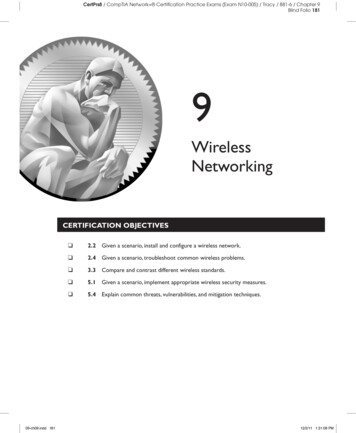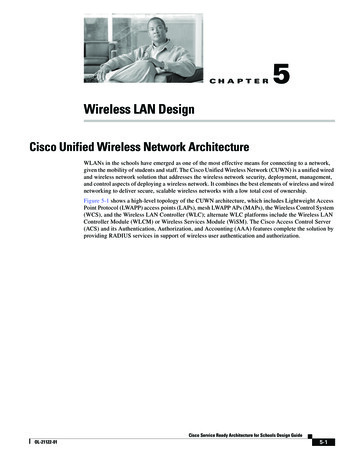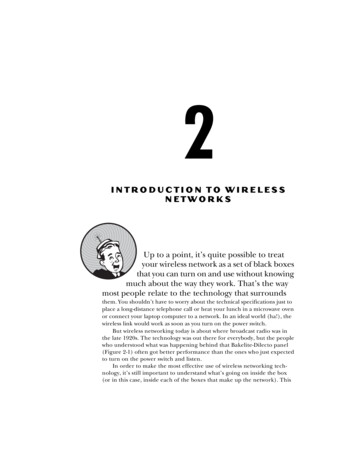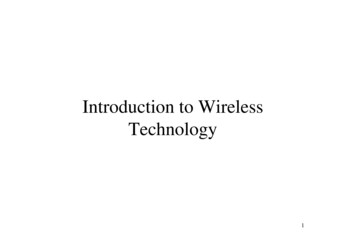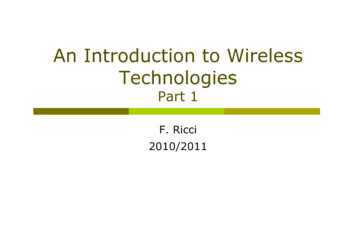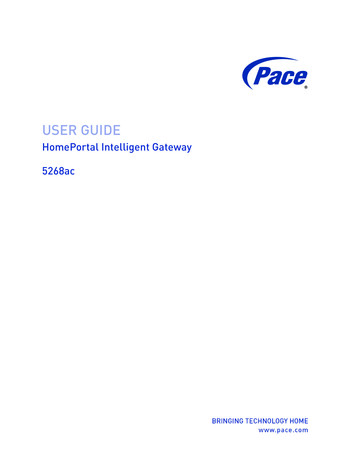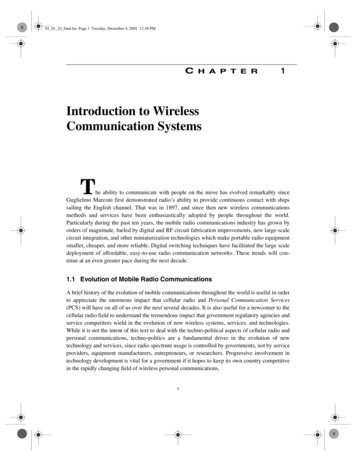
Transcription
01 01 24 final.fm Page 1 Tuesday, December 4, 2001 12:39 PMC H A P T E R1Introduction to WirelessCommunication SystemsThe ability to communicate with people on the move has evolved remarkably sinceGuglielmo Marconi first demonstrated radio’s ability to provide continuous contact with shipssailing the English channel. That was in 1897, and since then new wireless communicationsmethods and services have been enthusiastically adopted by people throughout the world.Particularly during the past ten years, the mobile radio communications industry has grown byorders of magnitude, fueled by digital and RF circuit fabrication improvements, new large-scalecircuit integration, and other miniaturization technologies which make portable radio equipmentsmaller, cheaper, and more reliable. Digital switching techniques have facilitated the large scaledeployment of affordable, easy-to-use radio communication networks. These trends will continue at an even greater pace during the next decade.1.1 Evolution of Mobile Radio CommunicationsA brief history of the evolution of mobile communications throughout the world is useful in orderto appreciate the enormous impact that cellular radio and Personal Communication Services(PCS) will have on all of us over the next several decades. It is also useful for a newcomer to thecellular radio field to understand the tremendous impact that government regulatory agencies andservice competitors wield in the evolution of new wireless systems, services, and technologies.While it is not the intent of this text to deal with the techno-political aspects of cellular radio andpersonal communications, techno-politics are a fundamental driver in the evolution of newtechnology and services, since radio spectrum usage is controlled by governments, not by serviceproviders, equipment manufacturers, entrepreneurs, or researchers. Progressive involvement intechnology development is vital for a government if it hopes to keep its own country competitivein the rapidly changing field of wireless personal communications.1
01 01 24 final.fm Page 2 Tuesday, December 4, 2001 12:39 PM2Chapter 1 Introduction to Wireless Communication SystemsWireless communications is enjoying its fastest growth period in history, due to enablingtechnologies which permit widespread deployment. Historically, growth in the mobile communications field has come slowly, and has been coupled closely to technological improvements. Theability to provide wireless communications to an entire population was not even conceived untilBell Laboratories developed the cellular concept in the 1960s and 1970s [Nob62], [Mac79],[You79]. With the development of highly reliable, miniature, solid-state radio frequency hardwarein the 1970s, the wireless communications era was born. The recent exponential growth in cellularradio and personal communication systems throughout the world is directly attributable to newtechnologies of the 1970s, which are mature today. The future growth of consumer-based mobileand portable communication systems will be tied more closely to radio spectrum allocations andregulatory decisions which affect or support new or extended services, as well as to consumerneeds and technology advances in the signal processing, access, and network areas.The following market penetration data show how wireless communications in the consumer sector has grown in popularity. Figure 1.1 illustrates how mobile telephony has penetratedour daily lives compared with other popular inventions of the 20th century. Figure 1.1 is a bitmisleading since the curve labeled “mobile telephone” does not include nontelephone mobileradio applications, such as paging, amateur radio, dispatch, citizens band (CB), public service,cordless phones, or terrestrial microwave radio systems. In fact, in 1990, licensed noncellularradio systems in the U.S. had over 12 million users, more than twice the U.S. cellular user population at that time [FCC91]. With the phenomenal growth of wireless subscribers in the late1990s, combined with Nextel’s novel business approach of purchasing private mobile radiolicenses for bundling as a nationwide commercial cellular service, today’s subscriber base forcellular and Personal Communication Services (PCS) far outnumbers all noncellular licensedusers. Figure 1.1 shows that the first 35 years of mobile telephony saw little market penetrationdue to high cost and the technological challenges involved, but how, in the past decade, wirelesscommunications has been accepted by consumers at rates comparable to television and the videocassette recorder.By 1934, 194 municipal police radio systems and 58 state police stations had adoptedamplitude modulation (AM) mobile communication systems for public safety in the U.S. It wasestimated that 5,000 radios were installed in mobiles in the mid 1930s, and vehicle ignition noisewas a major problem for these early mobile users [Nob62]. In 1935, Edwin Armstrong demonstrated frequency modulation (FM) for the first time, and since the late 1930s, FM has been theprimary modulation technique used for mobile communication systems throughout the world.World War II accelerated the improvements of the world’s manufacturing and miniaturizationcapabilities, and these capabilities were put to use in large one-way and two-way consumer radioand television systems following the war. The number of U.S. mobile users climbed from severalthousand in 1940 to 86,000 by 1948, 695,000 by 1958, and about 1.4 million users in 1962[Nob62]. The vast majority of mobile users in the 1960s were not connected to the publicswitched telephone network (PSTN), and thus were not able to directly dial telephone numbersfrom their vehicles. With the boom in CB radio and cordless appliances such as garage door
01 01 24 final.fm Page 3 Tuesday, December 4, 2001 12:39 PMEvolution of Mobile Radio Communications3Figure 1.1 The growth of mobile telephony as compared with other popular inventions of the20th century.openers and telephones, the number of users of mobile and portable radio in 1995 was about 100million, or 37% of the U.S. population. Research in 1991 estimated between 25 and 40 millioncordless telephones were in use in the U.S. [Rap91c], and this number is estimated to be over100 million as of late 2001. The number of worldwide cellular telephone users grew from25,000 in 1984 to about 25 million in 1993 [Kuc91], [Goo91], [ITU94], and since then subscription-based wireless services have been experiencing customer growth rates well in excess of50% per year. As shown in Chapter 2, the worldwide subscriber base of cellular and PCS subscribers is approximately 630 million as of late 2001, compared with approximately 1 billionwired telephone lines. In the first few years of the 21st century, it is clear there will be an equalnumber of wireless and conventional wireline customers throughout the world! At the beginningof the 21st century, over 1% of the worldwide wireless subscriber population had already abandoned wired telephone service for home use, and had begun to rely solely on their cellular service provider for telephone access. Consumers are expected to increasingly use wireless serviceas their sole telephone access method in the years to come.
01 01 24 final.fm Page 4 Tuesday, December 4, 2001 12:39 PM4Chapter 1 Introduction to Wireless Communication Systems1.2 Mobile Radiotelephony in the U.S.In 1946, the first public mobile telephone service was introduced in twenty-five major Americancities. Each system used a single, high-powered transmitter and large tower in order to cover distances of over 50 km in a particular market. The early FM push-to-talk telephone systems of the late1940s used 120 kHz of RF bandwidth in a half-duplex mode (only one person on the telephone callcould talk at a time), even though the actual telephone-grade speech occupies only 3 kHz of baseband spectrum. The large RF bandwidth was used because of the difficulty in mass-producing tightRF filters and low-noise, front-end receiver amplifiers. In 1950, the FCC doubled the number ofmobile telephone channels per market, but with no new spectrum allocation. Improved technologyenabled the channel bandwidth to be cut in half to 60 kHz. By the mid 1960s, the FM bandwidth ofvoice transmissions was cut to 30 kHz. Thus, there was only a factor of four increase in spectrumefficiency due to technology advances from WWII to the mid 1960s. Also in the 1950s and 1960s,automatic channel trunking was introduced and implemented under the label IMTS (ImprovedMobile Telephone Service). With IMTS, telephone companies began offering full duplex, auto-dial,auto-trunking phone systems [Cal88]. However, IMTS quickly became saturated in major markets.By 1976, the Bell Mobile Phone service for the New York City market (a market of about10,000,000 people at the time) had only twelve channels and could serve only 543 payingcustomers. There was a waiting list of over 3,700 people [Cal88], and service was poor due to callblocking and usage over the few channels. IMTS is still in use in the U.S., but is very spectrallyinefficient when compared to today’s U.S. cellular system.During the 1950s and 1960s, AT&T Bell Laboratories and other telecommunications companies throughout the world developed the theory and techniques of cellular radiotelephony—theconcept of breaking a coverage zone (market) into small cells, each of which reuse portions of thespectrum to increase spectrum usage at the expense of greater system infrastructure [Mac79]. Thebasic idea of cellular radio spectrum allocation is similar to that used by the FCC when it allocatestelevision stations or radio stations with different channels in a region of the country, and then reallocates those same channels to different stations in a completely different part of the country.Channels are only reused when there is sufficient distance between the transmitters to prevent interference. However, cellular telephony relies on reusing the same channels within the same market orservice area. AT&T proposed the concept of a cellular mobile system to the FCC in 1968, althoughtechnology was not available to implement cellular telephony until the late 1970s. In 1983, the FCCfinally allocated 666 duplex channels (40 MHz of spectrum in the 800 MHz band, each channelhaving a one-way bandwidth of 30 kHz for a total spectrum occupancy of 60 kHz for each duplexchannel) for the U.S. Advanced Mobile Phone System (AMPS) [You79]. According to FCC rules,each city (called a market) was only allowed to have two cellular radio system providers, thus providing a duopoly within each market which would assure some level of competition. As described inChapters 3 and 11, the radio channels were split equally between the two carriers. AMPS was thefirst U.S. cellular telephone system, and was deployed in late 1983 by Ameritech in Chicago, IL[Bou91]. In 1989, the FCC granted an additional 166 channels (10 MHz) to U.S. cellular serviceproviders to accommodate the rapid growth and demand. Figure 1.2 illustrates the spectrum
01 01 24 final.fm Page 5 Tuesday, December 4, 2001 12:39 PMMobile Radiotelephony in the U.S.5Forward ChannelReverse Channel991 992. 10231 2.799824-849 MHzChannel Number991992. 10231 2.799869-894 MHzCenter Frequency (MHz)Reverse Channel1 N 799991 N 10230.030N 825.00.030 ( N – 1023 ) 825.0Forward Channel1 N 799991 N 10230.030N 870.00.030 ( N – 1023 ) 870.0(Channels 800–990 are unused)Figure 1.2 Frequency spectrum allocation for the U.S. cellular radio service. Identically labeledchannels in the two bands form a forward and reverse channel pair used for duplex communicationbetween the base station and mobile. Note that the forward and reverse channels in each pair areseparated by 45 MHz.currently allocated for U.S. cellular telephone use. Cellular radio systems operate in an interferencelimited environment and rely on judicious frequency reuse plans (which are a function of themarket-specific propagation characteristics) and frequency division multiple access (FDMA) tomaximize capacity. These concepts will be covered in detail in subsequent chapters of this text.In late 1991, the first US Digital Cellular (USDC) system hardware was installed in majorU.S. cities. The USDC standard (Electronic Industry Association Interim Standard IS-54 andlater IS-136) allowed cellular operators to replace gracefully some single-user analog channelswith digital channels which support three users in the same 30 kHz bandwidth [EIA90]. In thisway, U.S. carriers gradually phased out AMPS as more users accepted digital phones. As discussed in Chapters 9 and 11, the capacity improvement offered by USDC is three times that ofAMPS, because digital modulation (π/4 differential quadrature phase shift keying), speech coding, and time division multiple access (TDMA) are used in place of analog FM and FDMA.Given the rate of digital signal processing advancements, speech coding technology willincrease the capacity to six users per channel in the same 30 kHz bandwidth within a few years,although Chapter 2 demonstrates how IS-136 will eventually be replaced by wideband CDMAtechnology.A cellular system based on code division multiple access (CDMA) has been developed byQualcomm, Inc. and standardized by the Telecommunications Industry Association (TIA) as anInterim Standard (IS-95). This system supports a variable number of users in 1.25 MHz widechannels using direct sequence spread spectrum. While the analog AMPS system requires thatthe signal be at least 18 dB above the co-channel interference to provide acceptable call quality,
01 01 24 final.fm Page 6 Tuesday, December 4, 2001 12:39 PM6Chapter 1 Introduction to Wireless Communication SystemsCDMA systems can operate at much larger interference levels because of their inherent interference resistance properties. The ability of CDMA to operate with a much smaller signal-to-noiseratio (SNR) than conventional narrowband FM techniques allows CDMA systems to use thesame set of frequencies in every cell, which provides a large improvement in capacity [Gil91].Unlike other digital cellular systems, the Qualcomm system uses a variable rate vocoder withvoice activity detection which considerably reduces the required data rate and also the batterydrain by the mobile transmitter.In the early 1990s, a new specialized mobile radio service (SMR) was developed to competewith U.S. cellular radio carriers. By purchasing small groups of radio system licenses from a largenumber of independent private radio service providers throughout the country, Nextel and Motorolaformed an extended SMR (E-SMR) network in the 800 MHz band that provides capacity and services similar to cellular. Using Motorola’s integrated radio system (MIRS), SMR integrates voicedispatch, cellular phone service, messaging, and data transmission capabilities on the same network[Fil95]. In 1995, Motorola replaced MIRS with the integrated digital enhanced network (iDen).Personal Communication Service (PCS) licenses in the 1800/1900 MHz band were auctioned by the U.S. Government to wireless providers in early 1995, and these have spawned newwireless services that complement, as well as compete with, cellular and SMR. One of the stipulations of the PCS license was that a majority of the coverage area be operational before the year2000. Each PCS licensee was able to “build-out” each market well in advance of this deadline.As many as five PCS licenses are allocated for each major U.S. city (see Chapter 11).1.3 Mobile Radio Systems Around the WorldMany mobile radio standards have been developed for wireless systems throughout the world, andmore standards are likely to emerge. Tables 1.1 through 1.3 list the most common paging, cordless,cellular, and personal communications standards used in North America, Europe, and Japan. Thedifferences between the basic types of wireless systems are described in Section 1.5, and are covered in detail in Chapter 11.The world’s most common paging standard is the Post Office Code Standard AdvisoryGroup (POCSAG) [CCI86], [San82]. POCSAG was developed by the British Post Office in thelate 1970s and supports binary frequency shift keying (FSK) signaling at 512 bps, 1200 bps, and2400 bps. New paging systems, such as FLEX and ERMES, provide up to 6400 bps transmissionsby using 4-level modulation and are currently being deployed throughout the world.The CT2 and Digital European Cordless Telephone (DECT) standards developed inEurope are the two most popular cordless telephone standards throughout Europe and Asia. TheCT2 system makes use of microcells which cover small distances, usually less than 100 m, usingbase stations with antennas mounted on street lights or on sides of buildings. The CT2 systemuses battery efficient frequency shift keying along with a 32 kbps adaptive differential pulsecode modulation (ADPCM) speech coder for high quality voice transmission. Handoffs betweenbase stations are not supported in CT2, as it is intended to provide short range access to thePSTN. The DECT system accommodates data and voice transmissions for office and business
01 01 24 final.fm Page 7 Tuesday, December 4, 2001 12:39 PMMobile Radio Systems Around the WorldTable 1.17Major Mobile Radio Standards in North AmericaStandardTypeYear nneltionBandwidthAMPSCellular1983FDMA824-894 MHzFM30 kHzNAMPSCellular1992FDMA824-894 MHzFM10 kHzUSDCCellular1991TDMA824-894 MHzπ/4DQPSK30 kHz824-894 MHzGMSK30 DMA824-894 MHz1.8-2.0 GHzQPSK/BPSK1.25 MHzGSCPaging1970sSimplexSeveralFSK12.5 kHzPOCSAGPaging1970sSimplexSeveralFSK12.5 kHzFLEXPaging1993SimplexSeveral4-FSK15 kHzDCS-1900(GSM)PCS1994TDMA1.85-1.99 GHzGMSK200 kHzPACSCordless/PCS1994TDMA/FDMA1.85-1.99 GHzπ/4DQPSK300 kHzMIRSSMR/PCS1994TDMASeveral16-QAM25 kHziDenSMR/PCS1995TDMASeveral16-QAM25 kHzusers. In the U.S., the PACS standard, developed by Bellcore and Motorola, is likely to be usedinside office buildings as a wireless voice and data telephone system or radio local loop. ThePersonal Handyphone System (PHS) standard supports indoor and local loop applications inJapan. Local loop concepts are explained in Chapter 10.The world’s first cellular system was implemented by the Nippon Telephone and Telegraphcompany (NTT) in Japan. The system, deployed in 1979, uses 600 FM duplex channels (25 kHzfor each one-way link) in the 800 MHz band. In Europe, the Nordic Mobile Telephone system
01 01 24 final.fm Page 8 Tuesday, December 4, 2001 12:39 PM8Chapter 1 Introduction to Wireless Communication SystemsTable 1.2Major Mobile Radio Standards in EuropeStandardTypeYear nChannelBandwidthETACSCellular1985FDMA900 MHzFM25 kHzNMT-450Cellular1981FDMA450-470 MHzFM25 kHzNMT-900Cellular1986FDMA890-960 MHzFM12.5 kHzGSMCellular/PCS1990TDMA890-960 MHzGMSK200 kHzC-450Cellular1985FDMA450-465 MHzFM20 kHz/10 kHzERMESPaging1993FDMASeveral4-FSK25 kHzCT2Cordless1989FDMA864-868 MHzGFSK100 kHzDECTCordless1993TDMA1880-1900MHzGFSK1.728 MHzDCS-1800Cordless/PCSTDMA1710-1880MHzGMSK200 kHzTable 1.31993Major Mobile Radio Standards in JapanStandardTypeYear nChannelBandwidthJTACSCellular1988FDMA860-925 MHzFM25 kHz25 kHzPDCCellular1993TDMA810-1501 MHzπ/4DQPSKNTTCellular1979FDMA400/800 MHzFM25 kHzNTACSCellular1993FDMA843-925 MHzFM12.5 kHzNTTPaging1979FDMA280 MHzFSK12.5 kHzNECPaging1979FDMASeveralFSK10 kHzPHSCordless1993TDMA1895-1907 MHzπ/4DQPSK300 kHz
01 01 24 final.fm Page 9 Tuesday, December 4, 2001 12:39 PMExamples of Wireless Communication Systems9(NMT 450) was developed in 1981 for the 450 MHz band and uses 25 kHz channels. TheEuropean Total Access Cellular System (ETACS) was deployed in 1985 and is virtually identicalto the U.S. AMPS system, except that the smaller bandwidth channels result in a slight degradationof signal-to-noise ratio (SNR) and coverage range. In Germany, a cellular standard called C-450was introduced in 1985. The first generation European cellular systems are generally incompatiblewith one another because of the different frequencies and communication protocols used. Thesesystems are now being replaced by the Pan European digital cellular standard GSM (GlobalSystem for Mobile) which was first deployed in 1990 in a new 900 MHz band which all of Europededicated for cellular telephone service [Mal89]. As discussed in Chapters 2 and 11, the GSMstandard has gained worldwide acceptance as the first universal digital cellular system with modernnetwork features extended to each mobile user, and is the leading digital air interface for PCS services above 1800 MHz throughout the world. In Japan, the Pacific Digital Cellular (PDC) standardprovides digital cellular coverage using a system similar to North America’s USDC.1.4 Examples of Wireless Communication SystemsMost people are familiar with a number of mobile radio communication systems used in everydaylife. Garage door openers, remote controllers for home entertainment equipment, cordless telephones, hand-held walkie-talkies, pagers (also called paging receivers or “beepers”), and cellulartelephones are all examples of mobile radio communication systems. However, the cost, complexity,performance, and types of services offered by each of these mobile systems are vastly different.The term mobile has historically been used to classify any radio terminal that could bemoved during operation. More recently, the term mobile is used to describe a radio terminal thatis attached to a high speed mobile platform (e.g., a cellular telephone in a fast moving vehicle)whereas the term portable describes a radio terminal that can be hand-held and used by someoneat walking speed (e.g., a walkie-talkie or cordless telephone inside a home). The term subscriberis often used to describe a mobile or portable user because in most mobile communication systems, each user pays a subscription fee to use the system, and each user’s communication deviceis called a subscriber unit. In general, the collective group of users in a wireless system arecalled users or mobiles, even though many of the users may actually use portable terminals. Themobiles communicate to fixed base stations which are connected to a commercial power sourceand a fixed backbone network. Table 1.4 lists definitions of terms used to describe elements ofwireless communication systems.Mobile radio transmission systems may be classified as simplex, half-duplex or full-duplex.In simplex systems, communication is possible in only one direction. Paging systems, in whichmessages are received but not acknowledged, are simplex systems. Half-duplex radio systemsallow two-way communication, but use the same radio channel for both transmission and reception. This means that at any given time, a user can only transmit or receive information. Constraintslike “push-to-talk” and “release-to-listen” are fundamental features of half-duplex systems. Fullduplex systems, on the other hand, allow simultaneous radio transmission and reception between a
01 01 24 final.fm Page 10 Tuesday, December 4, 2001 12:39 PM10Table 1.4Chapter 1 Introduction to Wireless Communication SystemsWireless Communications System DefinitionsBase StationA fixed station in a mobile radio system used for radio communication with mobilestations. Base stations are located at the center or on the edge of a coverage regionand consist of radio channels and transmitter and receiver antennas mounted on atower.Control ChannelRadio channel used for transmission of call setup, call request, call initiation, andother beacon or control purposes.Forward ChannelRadio channel used for transmission of information from the base station to themobile.Full DuplexSystemsCommunication systems which allow simultaneous two-way communication.Transmission and reception is typically on two different channels (FDD) althoughnew cordless/PCS systems are using TDD.Half DuplexSystemsCommunication systems which allow two-way communication by using the sameradio channel for both transmission and reception. At any given time, the user canonly either transmit or receive information.HandoffThe process of transferring a mobile station from one channel or base station toanother.Mobile StationA station in the cellular radio service intended for use while in motion at unspecified locations. Mobile stations may be hand-held personal units (portables) orinstalled in vehicles (mobiles).Mobile SwitchingCenterSwitching center which coordinates the routing of calls in a large service area. In acellular radio system, the MSC connects the cellular base stations and the mobilesto the PSTN. An MSC is also called a mobile telephone switching office (MTSO).PageA brief message which is broadcast over the entire service area, usually in a simulcast fashion by many base stations at the same time.Reverse ChannelRadio channel used for transmission of information from the mobile to base station.RoamerA mobile station which operates in a service area (market) other than that fromwhich service has been subscribed.Simplex SystemsCommunication systems which provide only one-way communication.SubscriberA user who pays subscription charges for using a mobile communications system.TransceiverA device capable of simultaneously transmitting and receiving radio signals.subscriber and a base station, by providing two simultaneous but separate channels (frequencydivision duplex, or FDD) or adjacent time slots on a single radio channel (time division duplex, orTDD) for communication to and from the user.Frequency division duplexing (FDD) provides simultaneous radio transmission channelsfor the subscriber and the base station, so that they both may constantly transmit while simultaneously receiving signals from one another. At the base station, separate transmit and receiveantennas are used to accommodate the two separate channels. At the subscriber unit, however, asingle antenna is used for both transmission to and reception from the base station, and a devicecalled a duplexer is used inside the subscriber unit to enable the same antenna to be used for
01 01 24 final.fm Page 11 Tuesday, December 4, 2001 12:39 PMExamples of Wireless Communication Systems11simultaneous transmission and reception. To facilitate FDD, it is necessary to separate the transmit and receive frequencies by about 5% of the nominal RF frequency, so that the duplexer canprovide sufficient isolation while being inexpensively manufactured.In FDD, a pair of simplex channels with a fixed and known frequency separation is used todefine a specific radio channel in the system. The channel used to convey traffic to the mobile userfrom a base station is called the forward channel, while the channel used to carry traffic from themobile user to a base station is called the reverse channel. In the U.S. AMPS standard, the reversechannel has a frequency which is exactly 45 MHz lower than that of the forward channel. Fullduplex mobile radio systems provide many of the capabilities of the standard telephone, with theadded convenience of mobility. Full duplex and half-duplex systems use transceivers for radiocommunication. FDD is used exclusively in analog mobile radio systems and is described in moredetail in Chapter 9.Time division duplexing (TDD) uses the fact that it is possible to share a single radio channelin time, so that a portion of the time is used to transmit from the base station to the mobile, and theremaining time is used to transmit from the mobile to the base station. If the data transmission ratein the channel is much greater than the end-user’s data rate, it is possible to store information burstsand provide the appearance of full duplex operation to a user, even though there are not two simultaneous radio transmissions at any instant. TDD is only possible with digital transmission formatsand digital modulation, and is very sensitive to timing. It is for this reason that TDD has onlyrecently been used, and only for indoor or small area wireless applications where the physicalcoverage distances (and thus the radio propagation time delay) are much smaller than the manykilometers used in conventional cellular telephone systems.1.4.1Paging SystemsPaging systems are communication systems that send brief messages to a subscriber. Depending onthe type of service, the message may be either a numeric message, an alphanumeric message, or avoice message. Paging systems are typically used to notify a subscriber of the need to call a particular telephone number or travel to a known location to receive further instructions. In modern pagingsystems, news headlines, stock quotations, and faxes may be sent. A message is sent to a pagingsubscriber via the paging system access number (usually a toll-free telephone number) with a telephone keypad or modem. The issued message is called a page. The paging system then transmits thepage throughout the service area using base stations which broadcast the page on a radio carrier.Paging systems vary widely in their complexity and coverage area. While simple paging systems may cover a limited range of 2 to 5 km, or may even be confined to within individual buildings,wide area paging systems can provide worldwide coverage. Though paging receivers are simple andinexpensive, the transmission system required is quite sophisticated. Wide area paging systems consist of a network of telephone lines, many base station transmitters, and large radio towers thatsimultaneously broadcast a page from each base station (this is called simulcasting). Simulcasttransmitters may be located within the same service area or in different cities or countries. Pagingsystems are designed to provide reliable communication to subscribers wherever they are; whether
01 01 24 final.fm Page 12 Tuesday, December 4, 2001 12:39 PM12Chapter 1 Introduction to Wirele
ability to provide wireless communications to an entire population was not even conceived until Bell Laboratories developed the cellular concept in the 1960s and 1970s [Nob62], [Mac79], [You79]. With the development of highly reliable, miniature, solid-state radio frequency hardware in the 1970s, t



